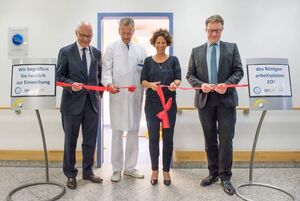Novel X-Ray System EOS

July 2015
Dietmar Hopp Foundation supports novel x-ray system with 760,000 Euros / Up to 90 percent less radiation exposure for patients / full-body studies while standing with short imaging time / three-dimensional imaging allows precise operative planning / especially children benefit from improved diagnostics, treatment planning, and follow up / official launch at the Department for Orthopedic, Trauma, and Spine Surgery at Heidelberg University Hospital.
Joining only a few hospitals in Germany, the Department of Orthopedic, Trauma, and Spine Surgery at Heidelberg University Hospital now has the new EOS x-ray system. This is based on the Nobel prize-winning “particle detector technology.” Thanks to lower radiation exposure, shorter imaging time even with full-body studies of standing patients, skeletal representation in natural attitude, and realistic three-dimensional image reconstruction, EOS significantly improves diagnostics, treatment planning, and follow up. Especially children and adolescents, as well as patients requiring frequent radiographic investigations, benefit.
On July 13th, 2015, the Dietmar Hopp Foundation officially consigned the innovative x-ray facility to Orthopedics in Heidelberg. Thanks to the generous donation of 760,000€ by the foundation, patients have been able to undergo investigations with the new machine since July 1, 2015. The device will be jointly operated by orthopedic and trauma surgeons headed by Professor Dr. Volker Ewerbeck, spokesman for the Department of Orthopedic, Trauma, and Spine Surgery, and by radiologists under direction of Professor Dr. Hans-Ulrich Kauczor, Medical Director of Diagnostic and Interventional Radiology.
Some 500 patients per year will be investigated with EOS
So far, ten patients have been examined using the new device. It is planned for approximately 500 patients of all ages to undergo x-rays with the EOS system annually. These will be particularly patients for whom corrective spine surgery is necessary. Similarly, children with growth-related deformities of the extremities, e.g. leg length discrepancies, and of the torso, e.g. pelvic misalignment, will especially benefit. EOS can also facilitate treatment planning for the insertion of artificial joints, e.g. hip or knee. “Almost all procedures in the realm of posture and movement in orthopedics and trauma surgery require precise planning to achieve or restore the desired anatomy of the affected area,” said Professor Ewerbeck.
One of the first patients undergoing investigation with the new EOS system in the Department of Orthopedics and Trauma Surgery was Dilara Dülger. The 16 year-old suffers from scoliosis, with twisting of the thoracic and lumbar spine. In patients with scoliosis, deformity of the spine can continue during growth. Thus, to initiate the necessary treatment at the appropriate time, clinical and radiological follow up are unavoidable. For Dilara, the spine deformity was increasing and the young patient had pain. Thanks to the new EOS technology, Heidelberg spine surgeons were able to plan the optimal corrective surgery. They performed high resolution full-body x-rays, analyzed the spine deformity of Dilara, and created a three-dimensional reconstruction using the data sets. The operation was performed three weeks ago now in the Division of Spine Surgery of the Department for Orthopedic and Trauma Surgery, and Dilara is doing very well. Her spine will continue to require regular x-ray follow up examinations in the future; thus, she will continue to reap more benefits from the more gentle EOS investigations with extremely low radiation exposure. In patients with spinal deformities, it is generally necessary to image the entire spine regularly to evaluate the disease optimally.
Patients benefit from Nobel Prize Technology
The best images in a short time with minimal radiation exposure – this enables the union between the Nobel Prize-winning “particle detector technology” (Physics Nobel Prize 1992 to Georges Charpack) with “linear scanning technology.” With one scan, two x-ray streams arranged perpendicularly to one another penetrate the body region to be examined. Thus, simultaneous images in two planes are collected. Special particle detectors record the data, which can then be represented in realistic-appearing 3D computer-based depictions.
About the Dietmar Hopp Foundation:
www.dietmar-hopp-stiftung.de

